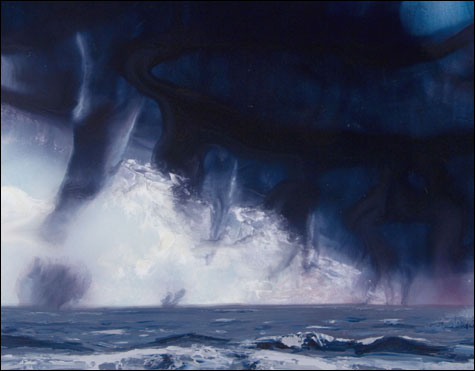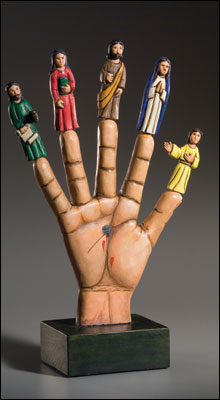
MULTI-WATERSPOUT The microcosmic gestures of paint in Rockman’s work speak to the grand
forces he’s depicting. |
“Keepers of Tradition: Art and FolkHeritage in Massachusetts” | National Heritage Museum, 33 Marrett Road, Lexington | Through February 8, 2009 “Alexis Rockman: The Weight of Air” | Rose Art Museum, Brandeis University, 415 South St, Waltham | Through July 27 |
There is always a tension between the old ways and the new. And maybe never more so than in a culture like ours, an immigrant society based on getting up and leaving the old behind, but still homesick. We’re a nation that’s by turns a melting pot in which the old ways dissolve into the new and a crazy quilt of one tradition bluntly stitched to the next.Here in Massachusetts, our old ways tend to reside in ethnic islands and pockets. They may be famous on their street or in their neighborhood or town, but they’re often unheard of outside it. So part of the thrill of “Keepers of Tradition: Art and Folk Heritage in Massachusetts” at Lexington’s National Heritage Museum is the news it brings of magic that’s close at hand but under the radar.
“Keepers of Tradition” collects work by 70 artists from across the state: Armenian lacework; African mud cloth; Puerto Rican masks; Cambodian dance; Native American, English, and colonial-style American ceramics; pottery; baskets; musical instruments; tin men; a fieldstone wall; a cow weathervane; scrimshaw; ship models. A pieced quilt by Sally Palmer Field of Chelmsford has 176 squares, each one with a different star or leaf pattern. The autumn browns make it seem sedate, but it’s a tour-de-force of design and quilting. Thomas Matsuda of Conway carves a traditional Japanese Buddhist Bodhisattva out of wood. His technique is crisp and neat, as if he’d made the essential cuts and not one more.
Curated by state folklorist Maggie Holtzberg and organized by the museum (which is operated by the Masons) and the Massachusetts Cultural Council, “Keepers of Tradition” is the first exhibition to come out of the Massachusetts Cultural Council’s Folk Arts & Heritage Program, which began in 1999 with financial help from the National Endowment for the Arts and the goal of ferreting out and documenting folk artists and their work across the state. (The whole show is archived atwww.massfolkarts.org.) The program picks up the pieces of a state project that was begun in the late 1980s and then fell apart in the early ’90s, a casualty of one of our budget crises. It has since gone on to give grants to folk artists as well as pay them to train apprentices. It’s the sort of project that makes you proud of your government.
“Folk art” is a catchall, of course; what sets these artists (who include some of the finest in Massachusetts) apart is that they maintain old craft traditions and their work is rooted in functionality rather than pure æsthetics. There are marvels, but the focus is on craftsmanship and (Yankee?) reserve. You’ll find few of the alluringly bizarre creations that are often dubbed outsider art.
Carl Close Jr. of Concord contributes a hand-wrought metal door knocker decorated with three silvery flowers that looks like something out of a fairy tale. Essex’s Bob Brophy carves and paints wooden duck decoys of startling delicacy and realism. Carol Kostecki of Montague Center dyes eggs in a traditional Ukrainian style of dazzlingly precise little patterns of stars, diamonds, and grids.

LA MANO PODEROSA, SANTO|THE MOST
POWERFUL HAND Carlos Santiago Arroyo
carves and paints cedar to sculpt a traditional
Puerto Rican hand of Christ with the Holy
Family balanced on its fingertips. |
“Keepers of Tradition” reflects the diversity of the state better than any art show you’re likely to see for a long time. East Boston’s Feridun Özgören makes traditional Turkish marbled paper with Arabic calligraphy praising God. Amherst’s Carlos Santiago Arroyo carves and paints cedar to sculpt a traditional Puerto Rican hand of Christ with the Holy Family balanced on its fingertips. Sharon’s Ksenia Pokrovsky paints Russian Orthodox icons in red, orange, and gold. Her triptych depicting the nativity of Christ resembles paintings from mediæval Europe in its bold graphic simplicity.One letdown is the presentation of Fruit Cocktail, a costume by Errol Phillip of Jamaica Plain. When worn at the 2007 Boston Caribbean Carnival, it was a spectacular confection of metal, fabric, feathers, and sequins. Here it’s incomplete — a sparkling crown and only some of the big wings. It should have been the star of the show.
These are artists driven to make things well and make things beautiful — sturdy and traditional, hand-hewn, expertly crafted, endearingly human in their imperfections. They radiate a flinty DIY independence. In our plastic, synthetic, digital society, their works represent the old thrill of seeing people be superb with their hands.